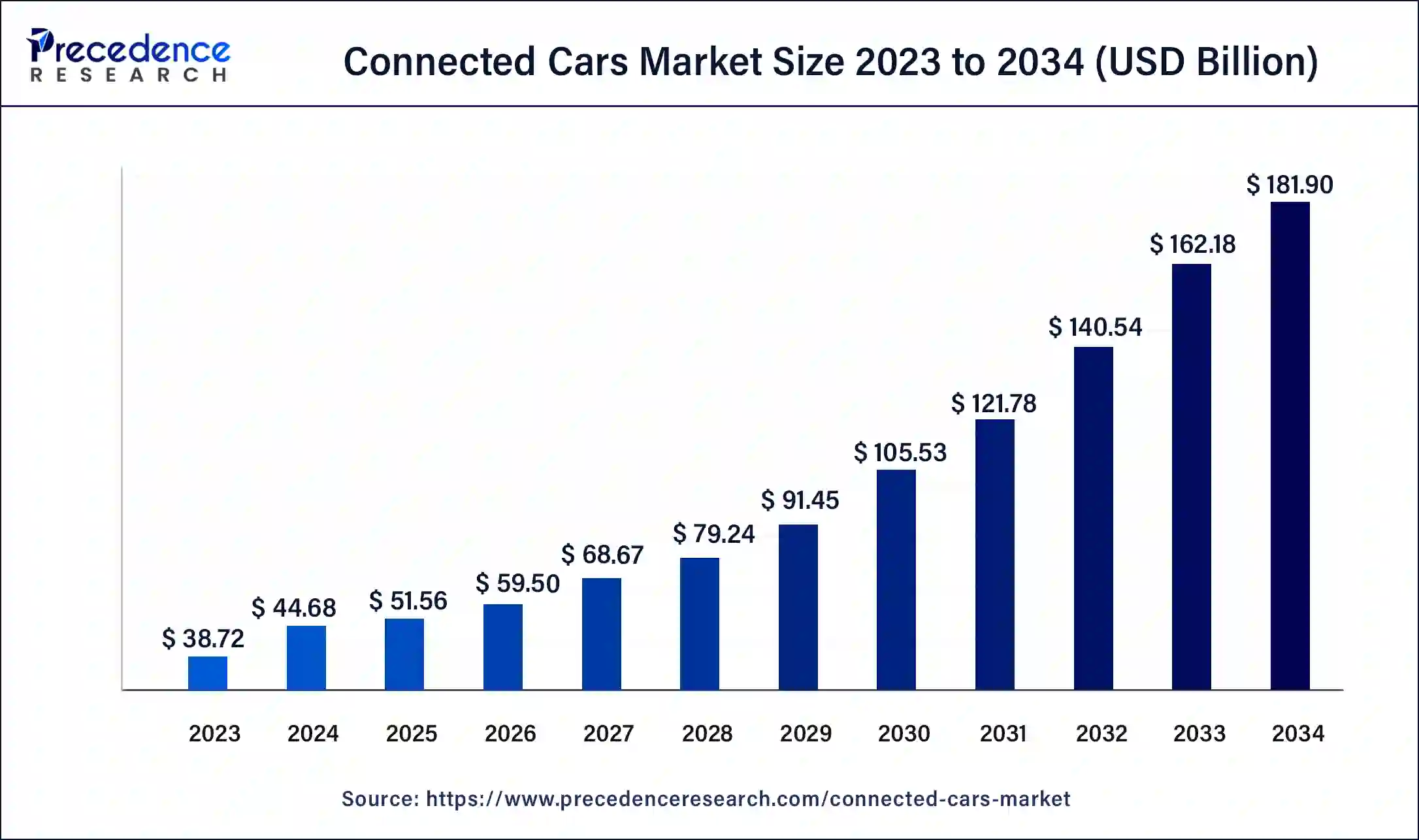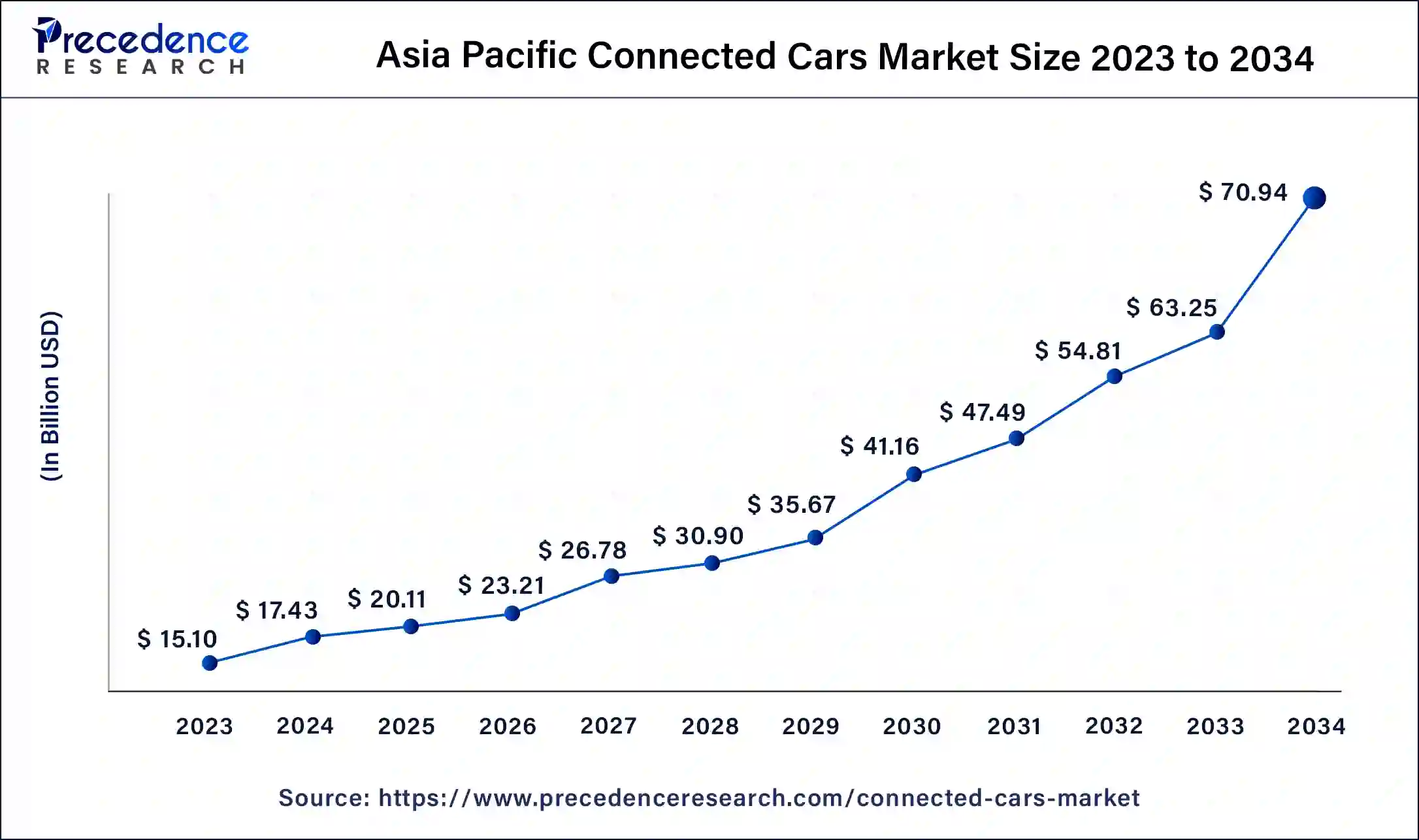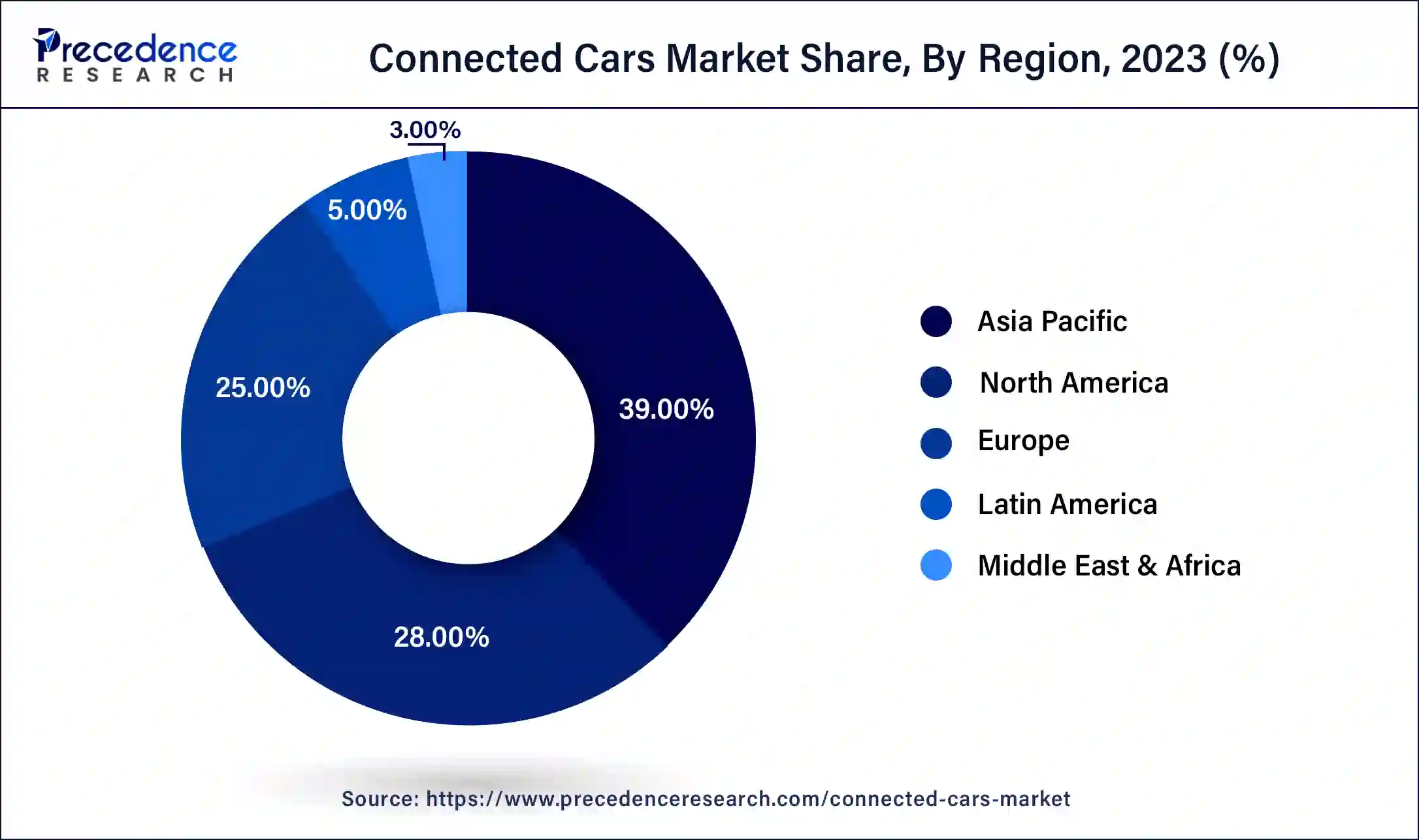What is the Connected Cars Market Size?
The global connected cars market size is estimated at USD 51.56 billion in 2025, and is calculated at USD 59.50 billion by 2026 and it is expected to reach around USD 181.90 billion by 2034, growing at a CAGR of 15.10% between 2025 and 2034.

Market Highlights
- Asia Pacific market has generated a maximum revenue share of around 38.5% in 2025.
- By service, the driver assistance segment accounted revenue share of around 34% in 2025.
- By technology, the 5G segment is dominate the market with a revenue share of 52% in 2025.
- By technology, the satellite segment is predicted to register the fastest growth from 2025 to 2034.
- By connectivity solution, the integrated segment has held a revenue share of 48% in 2025.
- By end-use, the OEM market segment has recorded a revenue share of 65% in 2025.
Market Size and Forecast
- Market Size in 2025: USD 51.56 Billion
- Market Size in 2026: USD 59.50 Billion
- Forecasted Market Size by 2034: USD 181.90 Billion
- CAGR (2025-2034): 15.10%
- Largest Market in 2024: Asia Pacific
Market Overview
Connected cars enable connectivity while providing performance, comfort, safety, and security in addition to strong network technology. The driver is able to converse in real-time by connecting to online networks in this manner. The rise in consumer demand for connectivity solutions, the surge in the need for continual connectivity, the rise in dependency on technology, and the rise in tech literacy among the populace are the main factors propelling the expansion of the global market for connected automobiles.
Machine-to-machine (M2M) communication platforms are among the connectivity solutions that automakers and service providers have developed throughout time. Its M2M functionality in a car allows two connected cars to communicate with one another. The car includes a lot of sensors and processors that provide the driver with accurate and current information.
Connected Cars Market Growth Factors
The market is expected to grow as a result of technological advancements, higher auto production, and rising customer demand for luxury and comfort in vehicles. Also, it is anticipated that issues like the expansion of international auto rules and the high maintenance costs of contemporary suspension systems will impede the development of the connected cars sector. Nonetheless, it is projected that the industry will have a higher chance of expanding as a result of the development of enhanced suspension systems and the rise in demand for lightweight suspension systems.
The priority for automakers now is to include connectivity options in their vehicles. Modern automobiles feature a variety of connectivity options, many of which depend on an internet connection to work. In a car, connectivity can be supplied by embedded, integrated, or tethered connectivity solutions. The driver and other passengers who ride in the car can access the internet via one of these connectivity options.
With a smartphone, modem, or networking device, an in-car hotspot can be established to give Internet access to all of the gadgets inside the car. As a result, the market for connected cars is expanding due to the rising trend of connectivity solutions.
Another significant development in this market is the increased deployment of cybersecurity solutions in-car safety systems. Data has recently emerged as a crucial element in the automotive sector. The infotainment system of the automobile is linked with the user's smartphone in connected vehicles.
The user's data may include bank and medical information, which could be subject to getting hacked. To stop data from being stolen, IT behemoths like Google and Apple are creating automobile cybersecurity apps. These apps are very user-friendly, keep an eye on the security of the car, and alert the owner if a stranger logs in using other devices. For instance, DENSO and Dellfer entered into a joint development agreement to create the cybersecurity product ZeroDayGaurd 1.0 for the automotive industry.
Market Scope
| Report Coverage | Details |
| Market Size in 2025 | USD 51.56 Billion |
| Market Size in 2026 | USD 59.50 Billion |
| Market Size by 2034 | USD 181.90 Billion |
| Market Growth Rate from 2025 to 2034 | CAGR of 6.36% |
| Dominating Region | Asia Pacific |
| Fastest Growing Region | North America |
| Base Year | 2025 |
| Forecast Period | 2025 to 2034 |
| Segments Covered | Technology, Connectivity Solution, Service, End Use and Region |
| Regions Covered | North America, Europe, Asia-Pacific, Latin America, and Middle East & Africa |
Market Dynamics
Drivers
Rise in trend of connectivity solution to drive the global connected car market
The idea of connectivity has changed throughout time as a result of smartphones. When travelling, people want to stay connected to the outside world. Automobile manufacturers incorporate connectivity options in their vehicles to boost sales now that connectivity is a necessity. Customers anticipate that their cars will fulfil similar functions to those of personal computers and cellphones.
The incorporation of connectivity technology has been given top emphasis by automakers. Several networking technologies used in modern cars nowadays require internet access in order to function properly. Connection systems that are embedded, integrated, or tethered can enable connectivity in a vehicle. Internet access for the driver and passengers of the car is one connectivity solution. An in-car hotspot can be created using a smartphone, modem, or networking device to provide Internet connectivity to any devices within the car. As a result, the market for connected cars is growing due to the popularity of connectivity solutions.
Restraint
Lack of uninterrupted & seamless internet connectivity
Keeping the consumer connected to the outside world is the primary goal of connected cars. Even when travelling, people require constant access to the internet. Customers anticipate that their cars will perform duties like to those of their computers or smartphones. Due to its inability to provide a seamless Internet connection, intermittent connectivity may serve as a barrier for the connected automobile market. This is primarily because service providers' networks are inconsistent and vary depending on the region.
Opportunity
Intelligent transportation system to provide opportunities for the global connected car market
The data interchange between the vehicle and the driver is one of the many innovative aftermarket technologies that connected automobiles offer as part of their safety features. To increase vehicle efficiency, save fuel and maintenance costs, strengthen security and safety measures, and improve the entire driving experience for the driver, safety blends telecommunications and automobile technology. Another element of connected cars that assists the driver in choosing the best route to their destination is the driver assistance system. Also, it delivers notifications about parking availability and traffic congestion. With the help of these connected car features, intelligent transportation systems can improve the driving experience.
Segments Insights
Technology Insights
The market is divided into 4 categories based on technology: 3G, 4G-LTE, satellite, and 5G. Throughout the projected period, it is anticipated that the 5G sector would dominate the market. For improved communication between connected automobiles and external devices, some telecommunications firms are creating sophisticated 5G networks. The 5G Automobile Association claims that a seamless 5G network can prevent more than 60% of traffic accidents. For instance, by investing more than USD 1.5 billion, South Korea and the EU have teamed up to create a 5G network for regional initiatives. This should reduce the increasing number of traffic accidents.
Over the projected period, the satellite segment is anticipated to develop at the fastest rate. Only urban regions with mobile towers are supported by cellular and Wi-Fi networks for connected cars. The network is entirely cut off once the car departs the mobile tower's perimeter, which could be extremely problematic for the people inside connected vehicles. To solve this issue and provide continuous connectivity, numerous automobile OEMs, satellite operators, and mobile operators concentrate on creating hybrid satellite-terrestrial networks. Thus, it is anticipated that the connected automobile industry would be driven by the rising demand for satellite and 5G networks.
Connectivity Solution Insights
The market is divided into embedded, tethered, and integrated systems depending on the type of connectivity solution. During the course of the projected period, the integrated segment is anticipated to rule the market. These technologies are more affordable than embedded and tethered systems and offer limitless data sharing options. Leading OEMs from all over the world have teamed up with other important businesses to create cutting-edge integrated solutions for connected vehicles that provide users with seamless communication. For instance, Ford and Geotab collaborated to provide a telematics solution for Ford automobiles.
The embedded market segment is anticipated to hold the second-largest share. Government regulations, cloud services, and cost-optimization of service plans are all anticipated to support its dominant position in the market.
Service Insights
The driver assistance sector is predicted to dominate the market during the projection period, according to market forecasts. Technology-advanced features that improve the safety of the car include adaptive cruise control, lane keep assist, 360-degree cameras, park assist, etc. Globally, numerous governments have established strict safety standards for automakers. For instance, the Indian automotive sector approved the BS-VI specification in April 2020, which mandates the installation of reverse parking sensors in all vehicle categories.
The market's second-largest category is of mobility management. With the help of this system, the driver may travel the shortest distance while using the least amount of fuel. Also, it provides crucial details about hazardous weather and road conditions.
End Use Insights
The market is divided into OEM and aftermarket segments based on the sales channel. The OEM market segment commands the biggest market share globally. Over the projection period, it is projected that rising technology advancements such as unbroken connectivity, cybersecurity, and the development of driverless vehicles linked with highly secure software will support OEMs' supremacy. An additional factor boosting the growth of the OEM industry is the expansion of partnerships with important players to create high-quality and affordable components.
Regional Insights
Asia Pacific Connected Cars Market Size and Growth 2025 to 2034
The Asia Pacific connected cars market size was valued at USD 120.11 billion in 2025 and is expected to be worth USD 70.94 billion by 2034, growing at a CAGR of 16% from 2025 to 2034.

North America contributed the notable revenue in 2025.It is anticipated that the connected cars market in North America would experience significant growth as a result of the development of the connected car network. Important telecommunications companies are also making investments in the creation of connected car capabilities. The growth of connected car services in North America has been facilitated by increased vehicle production and sales. In order to provide better and more effective service, connected service providers have made significant breakthroughs, leading to the expansion of the regional market.
The second-largest region is Europe.The countries of the UK, Germany, France, Russia, Italy, and the rest of Europe make up Europe. Investment firms provide cash to top connected car developers to encourage the use of cybersecurity in these vehicles. This is done to convey data safely. To enhance the driving experience, important automakers are now introducing new autonomous, connected cars. The connected car market in Europe has grown as a result of developments made by Europe's leading corporations to provide better and more effective connected car services. Also, the introduction of advanced technologies like ADAS has made it possible for automakers to provide linked services in vehicles, resulting in the expansion of the European market.

Third, in size is the Asia-Pacific. China, Japan, India, South Korea, and the other Asian countries make up Asia-Pacific. A large number of automakers with operations in the Asia-Pacific area have created connected services, which will ultimately aid in the growth of the connected car industry in the region. Due to the cooperation of well-known connected vehicle companies and the rollout of 5G networks for connected cars, the market for connected cars is expected to grow tremendously. The development of sophisticated wireless platforms by wireless service providers for connected vehicles is another initiative that is expected to aid in the growth of the Asia-Pacific connected car industry.
Connected Cars Market Companies
- Airbiquity Inc.
- AT&T
- Audi AG
- BMW Group
- CloudMade
- Continental AG
- Daimler AG
- Ford Motor Company
- Intellias Ltd.
- LUXOFT
Recent Developments:
- In June 2021, Payment24, a top provider of fuel management and payment solutions, introduced a smart refuelling programme with biometric features for connected automobiles. As the registered car pulls up to the fueling station, the module permits automated fuel approval and payment withdrawal. The service is expected to significantly lower fuel frauds and waste.
- In June 2021, Garrett Motion Inc., a unique technology company, unveiled Model-based Predictive Control (MPO) software in partnership with Hyundai Motor Company. The programme will offer cutting-edge approaches to vehicle health management.
Segments Covered in the Report
By Technology
- 3G
- 4G/LTE
- 5G
By Connectivity Solution
- Integrated
- Embedded
- Tethered
By Service
- Driver Assistance
- Safety
- Entertainment
- Well-being
- Vehicle Management
- Mobility Management
By End Use
- OEM
- Aftermarket
By Region
- North America
- Europe
- Asia-Pacific
- Latin America
- The Middle East and Africa
For inquiries regarding discounts, bulk purchases, or customization requests, please contact us at sales@precedenceresearch.com
Frequently Asked Questions
Ask For Sample
No cookie-cutter, only authentic analysis – take the 1st step to become a Precedence Research client
 sales@precedenceresearch.com
sales@precedenceresearch.com
 +1 804-441-9344
+1 804-441-9344